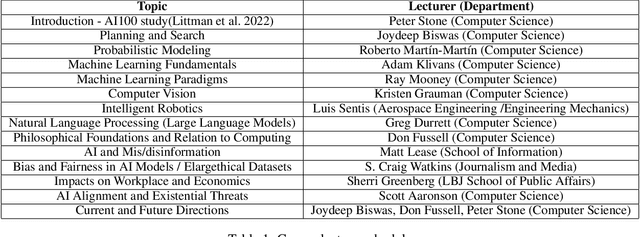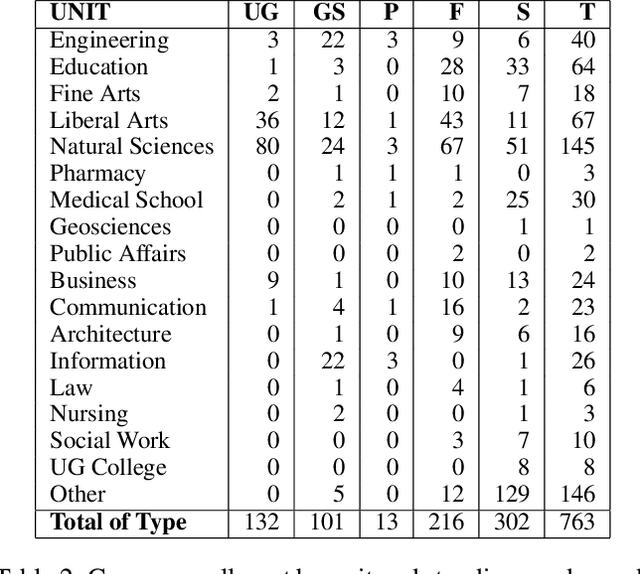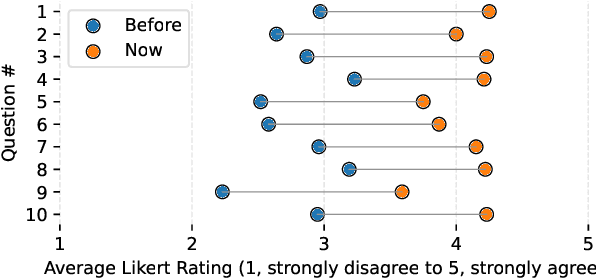Peter Stone
UT Austin, Sony AI
SocialNav-SUB: Benchmarking VLMs for Scene Understanding in Social Robot Navigation
Sep 10, 2025Abstract:Robot navigation in dynamic, human-centered environments requires socially-compliant decisions grounded in robust scene understanding. Recent Vision-Language Models (VLMs) exhibit promising capabilities such as object recognition, common-sense reasoning, and contextual understanding-capabilities that align with the nuanced requirements of social robot navigation. However, it remains unclear whether VLMs can accurately understand complex social navigation scenes (e.g., inferring the spatial-temporal relations among agents and human intentions), which is essential for safe and socially compliant robot navigation. While some recent works have explored the use of VLMs in social robot navigation, no existing work systematically evaluates their ability to meet these necessary conditions. In this paper, we introduce the Social Navigation Scene Understanding Benchmark (SocialNav-SUB), a Visual Question Answering (VQA) dataset and benchmark designed to evaluate VLMs for scene understanding in real-world social robot navigation scenarios. SocialNav-SUB provides a unified framework for evaluating VLMs against human and rule-based baselines across VQA tasks requiring spatial, spatiotemporal, and social reasoning in social robot navigation. Through experiments with state-of-the-art VLMs, we find that while the best-performing VLM achieves an encouraging probability of agreeing with human answers, it still underperforms simpler rule-based approach and human consensus baselines, indicating critical gaps in social scene understanding of current VLMs. Our benchmark sets the stage for further research on foundation models for social robot navigation, offering a framework to explore how VLMs can be tailored to meet real-world social robot navigation needs. An overview of this paper along with the code and data can be found at https://larg.github.io/socialnav-sub .
A Benchmark for Generalizing Across Diverse Team Strategies in Competitive Pokémon
Jun 12, 2025Abstract:Developing AI agents that can robustly adapt to dramatically different strategic landscapes without retraining is a central challenge for multi-agent learning. Pok\'emon Video Game Championships (VGC) is a domain with an extraordinarily large space of possible team configurations of approximately $10^{139}$ - far larger than those of Dota or Starcraft. The highly discrete, combinatorial nature of team building in Pok\'emon VGC causes optimal strategies to shift dramatically depending on both the team being piloted and the opponent's team, making generalization uniquely challenging. To advance research on this problem, we introduce VGC-Bench: a benchmark that provides critical infrastructure, standardizes evaluation protocols, and supplies human-play datasets and a range of baselines - from large-language-model agents and behavior cloning to reinforcement learning and empirical game-theoretic methods such as self-play, fictitious play, and double oracle. In the restricted setting where an agent is trained and evaluated on a single-team configuration, our methods are able to win against a professional VGC competitor. We extensively evaluated all baseline methods over progressively larger team sets and find that even the best-performing algorithm in the single-team setting struggles at scaling up as team size grows. Thus, policy generalization across diverse team strategies remains an open challenge for the community. Our code is open sourced at https://github.com/cameronangliss/VGC-Bench.
SLAC: Simulation-Pretrained Latent Action Space for Whole-Body Real-World RL
Jun 07, 2025Abstract:Building capable household and industrial robots requires mastering the control of versatile, high-degree-of-freedom (DoF) systems such as mobile manipulators. While reinforcement learning (RL) holds promise for autonomously acquiring robot control policies, scaling it to high-DoF embodiments remains challenging. Direct RL in the real world demands both safe exploration and high sample efficiency, which are difficult to achieve in practice. Sim-to-real RL, on the other hand, is often brittle due to the reality gap. This paper introduces SLAC, a method that renders real-world RL feasible for complex embodiments by leveraging a low-fidelity simulator to pretrain a task-agnostic latent action space. SLAC trains this latent action space via a customized unsupervised skill discovery method designed to promote temporal abstraction, disentanglement, and safety, thereby facilitating efficient downstream learning. Once a latent action space is learned, SLAC uses it as the action interface for a novel off-policy RL algorithm to autonomously learn downstream tasks through real-world interactions. We evaluate SLAC against existing methods on a suite of bimanual mobile manipulation tasks, where it achieves state-of-the-art performance. Notably, SLAC learns contact-rich whole-body tasks in under an hour of real-world interactions, without relying on any demonstrations or hand-crafted behavior priors. More information, code, and videos at robo-rl.github.io
ROTATE: Regret-driven Open-ended Training for Ad Hoc Teamwork
May 29, 2025Abstract:Developing AI agents capable of collaborating with previously unseen partners is a fundamental generalization challenge in multi-agent learning, known as Ad Hoc Teamwork (AHT). Existing AHT approaches typically adopt a two-stage pipeline, where first, a fixed population of teammates is generated with the idea that they should be representative of the teammates that will be seen at deployment time, and second, an AHT agent is trained to collaborate well with agents in the population. To date, the research community has focused on designing separate algorithms for each stage. This separation has led to algorithms that generate teammate pools with limited coverage of possible behaviors, and that ignore whether the generated teammates are easy to learn from for the AHT agent. Furthermore, algorithms for training AHT agents typically treat the set of training teammates as static, thus attempting to generalize to previously unseen partner agents without assuming any control over the distribution of training teammates. In this paper, we present a unified framework for AHT by reformulating the problem as an open-ended learning process between an ad hoc agent and an adversarial teammate generator. We introduce ROTATE, a regret-driven, open-ended training algorithm that alternates between improving the AHT agent and generating teammates that probe its deficiencies. Extensive experiments across diverse AHT environments demonstrate that ROTATE significantly outperforms baselines at generalizing to an unseen set of evaluation teammates, thus establishing a new standard for robust and generalizable teamwork.
Towards Natural Language Communication for Cooperative Autonomous Driving via Self-Play
May 23, 2025Abstract:Past work has demonstrated that autonomous vehicles can drive more safely if they communicate with one another than if they do not. However, their communication has often not been human-understandable. Using natural language as a vehicle-to-vehicle (V2V) communication protocol offers the potential for autonomous vehicles to drive cooperatively not only with each other but also with human drivers. In this work, we propose a suite of traffic tasks in autonomous driving where vehicles in a traffic scenario need to communicate in natural language to facilitate coordination in order to avoid an imminent collision and/or support efficient traffic flow. To this end, this paper introduces a novel method, LLM+Debrief, to learn a message generation and high-level decision-making policy for autonomous vehicles through multi-agent discussion. To evaluate LLM agents for driving, we developed a gym-like simulation environment that contains a range of driving scenarios. Our experimental results demonstrate that LLM+Debrief is more effective at generating meaningful and human-understandable natural language messages to facilitate cooperation and coordination than a zero-shot LLM agent. Our code and demo videos are available at https://talking-vehicles.github.io/.
A Champion-level Vision-based Reinforcement Learning Agent for Competitive Racing in Gran Turismo 7
Apr 12, 2025Abstract:Deep reinforcement learning has achieved superhuman racing performance in high-fidelity simulators like Gran Turismo 7 (GT7). It typically utilizes global features that require instrumentation external to a car, such as precise localization of agents and opponents, limiting real-world applicability. To address this limitation, we introduce a vision-based autonomous racing agent that relies solely on ego-centric camera views and onboard sensor data, eliminating the need for precise localization during inference. This agent employs an asymmetric actor-critic framework: the actor uses a recurrent neural network with the sensor data local to the car to retain track layouts and opponent positions, while the critic accesses the global features during training. Evaluated in GT7, our agent consistently outperforms GT7's built-drivers. To our knowledge, this work presents the first vision-based autonomous racing agent to demonstrate champion-level performance in competitive racing scenarios.
Offline Action-Free Learning of Ex-BMDPs by Comparing Diverse Datasets
Mar 26, 2025Abstract:While sequential decision-making environments often involve high-dimensional observations, not all features of these observations are relevant for control. In particular, the observation space may capture factors of the environment which are not controllable by the agent, but which add complexity to the observation space. The need to ignore these "noise" features in order to operate in a tractably-small state space poses a challenge for efficient policy learning. Due to the abundance of video data available in many such environments, task-independent representation learning from action-free offline data offers an attractive solution. However, recent work has highlighted theoretical limitations in action-free learning under the Exogenous Block MDP (Ex-BMDP) model, where temporally-correlated noise features are present in the observations. To address these limitations, we identify a realistic setting where representation learning in Ex-BMDPs becomes tractable: when action-free video data from multiple agents with differing policies are available. Concretely, this paper introduces CRAFT (Comparison-based Representations from Action-Free Trajectories), a sample-efficient algorithm leveraging differences in controllable feature dynamics across agents to learn representations. We provide theoretical guarantees for CRAFT's performance and demonstrate its feasibility on a toy example, offering a foundation for practical methods in similar settings.
Hyperspherical Normalization for Scalable Deep Reinforcement Learning
Feb 21, 2025Abstract:Scaling up the model size and computation has brought consistent performance improvements in supervised learning. However, this lesson often fails to apply to reinforcement learning (RL) because training the model on non-stationary data easily leads to overfitting and unstable optimization. In response, we introduce SimbaV2, a novel RL architecture designed to stabilize optimization by (i) constraining the growth of weight and feature norm by hyperspherical normalization; and (ii) using a distributional value estimation with reward scaling to maintain stable gradients under varying reward magnitudes. Using the soft actor-critic as a base algorithm, SimbaV2 scales up effectively with larger models and greater compute, achieving state-of-the-art performance on 57 continuous control tasks across 4 domains. The code is available at https://dojeon-ai.github.io/SimbaV2.
The Essentials of AI for Life and Society: An AI Literacy Course for the University Community
Jan 13, 2025



Abstract:We describe the development of a one-credit course to promote AI literacy at The University of Texas at Austin. In response to a call for the rapid deployment of class to serve a broad audience in Fall of 2023, we designed a 14-week seminar-style course that incorporated an interdisciplinary group of speakers who lectured on topics ranging from the fundamentals of AI to societal concerns including disinformation and employment. University students, faculty, and staff, and even community members outside of the University, were invited to enroll in this online offering: The Essentials of AI for Life and Society. We collected feedback from course participants through weekly reflections and a final survey. Satisfyingly, we found that attendees reported gains in their AI literacy. We sought critical feedback through quantitative and qualitative analysis, which uncovered challenges in designing a course for this general audience. We utilized the course feedback to design a three-credit version of the course that is being offered in Fall of 2024. The lessons we learned and our plans for this new iteration may serve as a guide to instructors designing AI courses for a broad audience.
Influencing Humans to Conform to Preference Models for RLHF
Jan 11, 2025



Abstract:Designing a reinforcement learning from human feedback (RLHF) algorithm to approximate a human's unobservable reward function requires assuming, implicitly or explicitly, a model of human preferences. A preference model that poorly describes how humans generate preferences risks learning a poor approximation of the human's reward function. In this paper, we conduct three human studies to asses whether one can influence the expression of real human preferences to more closely conform to a desired preference model. Importantly, our approach does not seek to alter the human's unobserved reward function. Rather, we change how humans use this reward function to generate preferences, such that they better match whatever preference model is assumed by a particular RLHF algorithm. We introduce three interventions: showing humans the quantities that underlie a preference model, which is normally unobservable information derived from the reward function; training people to follow a specific preference model; and modifying the preference elicitation question. All intervention types show significant effects, providing practical tools to improve preference data quality and the resultant alignment of the learned reward functions. Overall we establish a novel research direction in model alignment: designing interfaces and training interventions to increase human conformance with the modeling assumptions of the algorithm that will learn from their input.
 Add to Chrome
Add to Chrome Add to Firefox
Add to Firefox Add to Edge
Add to Edge